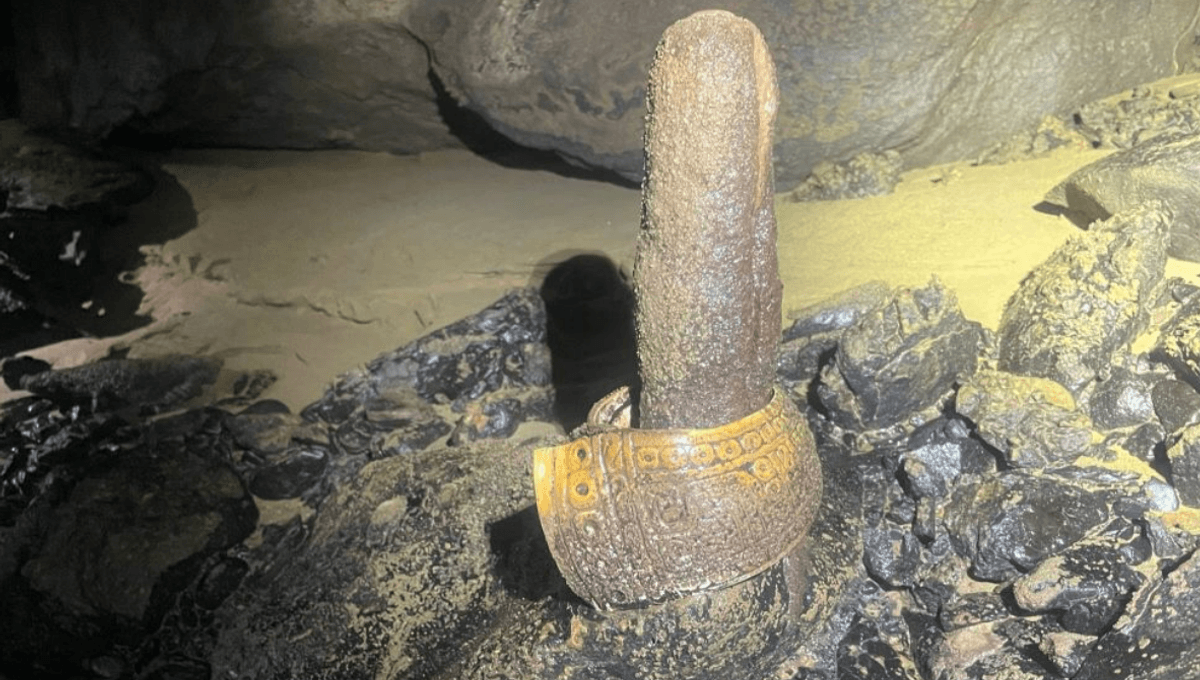-
Feed de notícias
- EXPLORAR
-
Páginas
-
Blogs
-
Fóruns
Daring Explorers Find Mesoamerican Fertility Ritual In Depths Of A Mexican Cave

Daring Cavers Discover A Mesomerican Fertility Ritual In The "Bowels Of Earth"
Deep within the flooded chambers of a remote Mexican cave, explorers initially mistook a glinting object for a piece of 21st-century trash. But what they had actually uncovered was something far more special: a centuries-old Mesoamerican bracelet, carefully placed atop a stalagmite as part of a mysterious fertility ritual.
Squeezing through caverns barely bigger than your belly is, believe or not, some people’s idea of a good time. Sometimes, however, extreme caves can show the fruits of their labor and prove their claustrophobic antics are worth the risk. Back in September 2023, Adrián Beltrán Dimas and Russian speleologist (that’s a cave scientist) Yekaterina Katiya Pavlova embarked on a mission to explore the Tlayócoc Cave, located in the Guerrero mountains of Mexico, a place long avoided due to local fears of "bad air." Even getting to the cave’s entrance is no small feat. Located one hour's walk from the nearest mountain town, the cave is set in rugged terrain riddled with snakes and pumas, which are prone to attack people in this region. They entered through one of the cave's two challenging openings and followed a narrow, water-filled passage. After advancing 150 meters (492 feet) in, the pair came across a narrow pool with a gap about 15 centimeters (under 6 inches) between the water and the ceiling of the cave. “I looked in, and it seemed like the cave continued. You had to hold your breath and dive a little to get through. Adrián was scared, but the water was deep enough, and I went through first to show him it wasn't that difficult,” Pavlova said in a statement. A glimpse inside the dark depths of the cave. Image credit: Guillermina Valente After helping Adrián past the obstacle, they continued about 30 meters (98 feet) until the cave ceiling became dangerously low, forcing them to stop and look around, unaware they were on the verge of a major discovery. "That's when we discovered the two rings around the stalagmites and the giant shell. The other ring was in the canal, a few meters back; we only saw it when we returned," the expert revealed. Upon searching around the cavern, they saw several bracelets that were perfectly placed on a stalagmite, like a ring on a finger. When they first saw the strangely situated object, they initially assumed it was a piece of modern trash that someone had carelessly left in the cavern. Upon closer inspection, they realized that it was a beautifully decorated, historical artifact. "It was very exciting,” commented Pavlova. After returning to Earth’s surface, the cavers alerted Mexico’s National Institute of Anthropology and History (INAH) to the loot they had stumbled across. In March 2025, they sent a new expedition of historians and archaeologists to officially document their finds. In total, they found three shell bracelets (possibly made from the sea snail species Triplofusus giganteus), a fragment of a shell bracelet, a decorated and perforated giant snail shell, a small piece of carbonized wood, two complete stone disks resembling pyrite mirrors, six disk fragments, and sediment samples. The archaeologists are certain that the pieces are from the Postclassic period, likely dating between 950 and 1521 CE, and probably belonged to the Tlacotepehua culture, which 16th-century historical sources say lived in this region. The ornately decorated bracelet (phallic object not included). Image credit: Miguel Pérez The bracelets feature depictions of a human figure, possibly representing a deity associated with the "morning star". Likewise, the shells are believed to have been decorated with images of other Mesoamerican gods, such as Quetzalcoatl or Tlahuizcalpantecuhtli. The placement of the bracelets on the stalagmites is no accident. The researchers believe these pointy cave features held “phallic connotations” and the rings were nestled on them as part of a fertility ritual that was performed in the cave. “For pre-Hispanic cultures, caves were sacred places, associated with the underworld and considered the womb of the Earth. There is a symbolic integration at the site, since, according to Mesoamerican myth, Quetzalcoatl was a deity who extracted, from the depths of the planet, the corn and bones from which humanity was formed and, through their sacrifice, gave rise to life, the knowledge of agriculture, and fertility,” explained Pérez Negrete, an archaeologist at the INAH.



